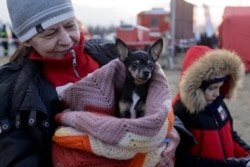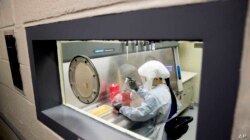On March 10, Russian Foreign Minister Sergey Lavrov met with his Ukrainian counterpart, Dmytro Kuleba, for peace talks in Turkey. The two sides failed to agree to a cease-fire two weeks into Russia’s invasion of Ukraine.
Despite the undeniable fact that Russia launched a war of aggression against its neighbor, Lavrov made the following statement:
"We are not planning to attack other countries. We didn't attack Ukraine in the first place.”
That prompted Kuleba to say later that Russian officials "live in their own reality.”
It is not just top officials. Moscow enforces war denialism both through controlling the information zone at home and criminalizing dissent.
On March 4, Russia passed a law making “false” information about Russia’s armed forces illegal. Violators face up to 15 years in prison.
Calling Russia’s “special military operation” in Ukraine a war, for example, is now against the law.
The Voice of America, its sister organization Radio Free Europe and Radio Liberty, the BBC and other Western media outlets were banned.
Unable to perform their duties without risk of criminal penalty, a host of media outlets suspended operations.
Russia’s last independent news network, TV Rain, and the liberal radio station Ekho Moskvy, which has previously featured translations of Polygraph.info’s work, were taken off the air for publishing "deliberately false information about the actions of Russian military personnel" in Ukraine.
Social media is also under attack. Use of Facebook has been blocked; use of Twitter restricted.
That has left Russia with what The New York Times’ former Moscow bureau chief called “an alternate reality.”
With the United States and other allies hitting Russia with unprecedented sanctions, Russians are being told that they are, in fact, the victims.
On March 9, popular state TV propagandist Vladimir Solovyov claimed the United States was seizing on “a historic chance to destroy Russia.” He argues that “Russia is blamed for everything.”
The following day, political commentator and Josef Stalin apologist Yaakov Kedmi appeared on the same program, “Evening With Vladimir Solovyov,” to warn that “a war of annihilation is being waged against [Russia],” its civilization and culture.
In reality, it is Russian President Vladimir Putin who has denied that Ukraine has “real statehood,” calling it part of Russia’s “own history, culture, spiritual space.” It is Russia that has launched a war against Ukraine that some analysts fear is intent on cultural genocide against Ukrainians.
Still, many Russians appear to back a war their media legally cannot call a war.
One recent survey conducted by a state-controlled pollster said that up to 71% of Russians support “the special military operation in Ukraine.”
Another independent survey showed that 58% of Russians approve of the war and 23% oppose it.
Some analysts warn that survey results taken in authoritarian societies (especially wartime ones) should not be viewed as valid.
That is likely the case now, because the Kremlin has systematically promoted multiple false narratives to the Russian public.
Myth: Russian forces are helping war victims, not creating them
Russian media is full of reports showing that Russian doctors are saving children in Eastern Ukraine from Ukrainian government shelling, while accusing Ukrainian forces of targeting civilian areas. It is Russia that is opening up humanitarian corridors, which are being fired upon by Ukraine’s armed forces, Russian state media reports.
State TV also broadcasts videos of the Russia military delivering humanitarian cargo and providing aid to refugees.
Actually, Russian forces have stepped up indiscriminate attacks on civilian areas, targeting hospitals, schools, and residential buildings. Russia has been embracing humanitarian corridors as a war tactic. News organizations have documented Russia shelling civilians fleeing to evacuation points.
The International Committee of Red Cross, for example, confirmed that an evacuation route out of the besieged port city of Mariupol had been mined, Newsweek reported.
Russia has used the conditions wrought by its 8-year-old clandestine war in two provinces of Eastern Ukraine to justify its purported campaign of “de-nazification.”
But as Polygraph.info previously reported, the U.N. High Commissioner for Human Rights (OHCHR) found almost as many civilians were killed in the first five days of Russia’s war than in the prior four years of war in the Donbas region.
On March 9, the OHCHR had recorded 1,424 civilian casualties in the country – 516 killed and 908 injured – since Russia invaded on February 24.
Only 24 deaths (less than 5% of the total) and 113 injuries were reported in the self-proclaimed Donetsk and Luhansk republics controlled by Russia in Donbas.
Although Russian state media claim the operation is aiding refugees, it is Russia’s invasion that caused more than 2 million people to flee westward to Poland, Romania, Moldova, Slovakia and Hungary.
A war crimes expert told Newsweek that Russia was intentionally starving Ukrainians, with those in the besieged city of Mariupol and elsewhere deprived of food and water, prompting warnings of a humanitarian catastrophe.
Myth: Everything is a Ukrainian provocation!
When Russia shelled the Zaporizhzhia nuclear power plant near Enerhodar, Ukraine, Russian state media called it a Ukrainian provocation.
When Russian forces seized Chernobyl, the site in Ukraine of a 1986 nuclear catastrophe, Russian state media claimed Ukrainian nationalists had planned provocations against the plant.
Russia’s airstrike against a maternity hospital in Mariupol? Also a provocation. The same goes for images of shelled cities and residential areas.
According to state media in Moscow, Ukrainians are shelling their own cities and killing civilians to blame it on Russia.
Russian officials have even labeled the victims of its attacks crisis actors, a tactic previously used by Russian state media in Syria. Just as in Syria, images from movies and television productions were used to spread the false claim that “crisis actors” were posing as injured people in Ukraine.
Also as in Syria, Russia has spread disinformation about chemical and biological weapons (more on that later).
The day Russia launched its invasion of Ukraine, the Russian Defense Ministry spokesman, Igor Konashenkov, signaled that Russia would attack civilian areas by preemptively blaming it on Ukraine.
He said Ukrainian security forces intended to stage videos showing mass casualties among Ukrainian civilians.
"Their goal is to accuse Russia of allegedly conducting non-selective and disproportionate strikes, and to intimidate the civilian population, as well as broadcast [these videos] on Western TV channels,” Konashenkov said.
Konashenkov also falsely claimed “Russian armed forces are not striking at the cities of Ukraine” or “threatening the civilian population.”
Likewise, Russian Foreign Ministry spokeswoman Maria Zakharova appeared to telegraph the March 9 airstrike on a Mariupol maternity hospital by alleging in advance – with no evidence – that Ukrainian nationalists had “kicked out all the patients and staff and set up firing points there.”
When images of a visibly injured pregnant woman leaving the bombed out maternity hospital surfaced, Russia called her a crisis actor.
Russian disinformation also falsely claimed a visibly injured woman from a Russian military attack on an apartment building in Chuhuiv was an employee of the 72nd Main Center of Information and Psychological Operations of Ukraine.
Myths: Biolabs, chemical weapons and COVID-19
The initial false pretext for war was the “de-nazification” and “demilitarization” of Ukraine, according to Russian President Vladimir Putin.
But as a side pretext, Russia is falsely accusing the United States of running biological weapons labs in Ukraine.
That propaganda line ties into false conspiracies previously spread by Russian and Chinese state media that COVID-19 is a bioweapon created at Fort Detrick, a U.S. military lab in Maryland.
The Soviet Union also created and spread the disinformation myth that human immunodeficiency virus (HIV) was created at Fort Detrick. That myth persists to this day.
Russian state media continues to spread the false claim that the United States is working with Ukrainian labs to develop biological weapons. Those accusations ramped up while Russia massed its invasion force on Ukraine’s borders.
Igor Kirillov, the head of the Nuclear, Biological, and Chemical Protection Troops of the Russian Armed Forces, has gone so far as to falsely claim, “We can say that one of the tasks of the United States and its allies is the creation of bioagents that can selectively affect various ethnic groups of the population.”
Russia’s Defense Ministry claimed, “The United States is training migratory birds to migrate from Ukraine to Russia and distribute bacteriological weapons.”
Those false claims were repeated by Russia’s ambassador to the United Nations.
U.S. State Department spokesman Ned Price said Moscow "is inventing false pretexts in an attempt to justify its own horrific actions in Ukraine.”
On February 25, the PolitiFact fact-checking website debunked the claim that “Russia is targeting U.S. biological weapons labs in Ukraine invasion.”
“There are no U.S. military-run labs in Ukraine,” Andy Weber, a member of the Arms Control Association Board of Directors, told PolitiFact.
As noted in the Bulletin of the Atomic Scientists, there are Ukrainian labs linked to the U.S. Biological Threat Reduction Program, which for decades has sought to eliminate the threat of the former Soviet Union’s weapons programs.
Russia has similarly accused the United States of creating bioweapons at Georgia’s Lugar Lab, another name for the Georgian Research Center in Tbilisi. (Russia went to war with Georgia in 2008, cleft off territory and created two proxy states.)
Russian lawmakers have insinuated that the Soviet-era nerve against used to poison imprisoned Russian dissident Alexey Navalny was produced at the Lugar Lab or in the United States.
In August 2020, Russian security forces poisoned Navalny on Russian soil with Novichok, a military-grade chemical weapon developed by the Soviet Union and later the Russian Federation.
Russia disinformation, like in Ukraine now, also tied the Lugar Lab to the emergence of COVID-19.
As noted by White House press secretary Jen Psaki on Twitter:
"It’s Russia that has a long and well-documented track record of using chemical weapons, including in attempted assassinations and poisoning of Putin’s political enemies like Alexey Navalny.”








